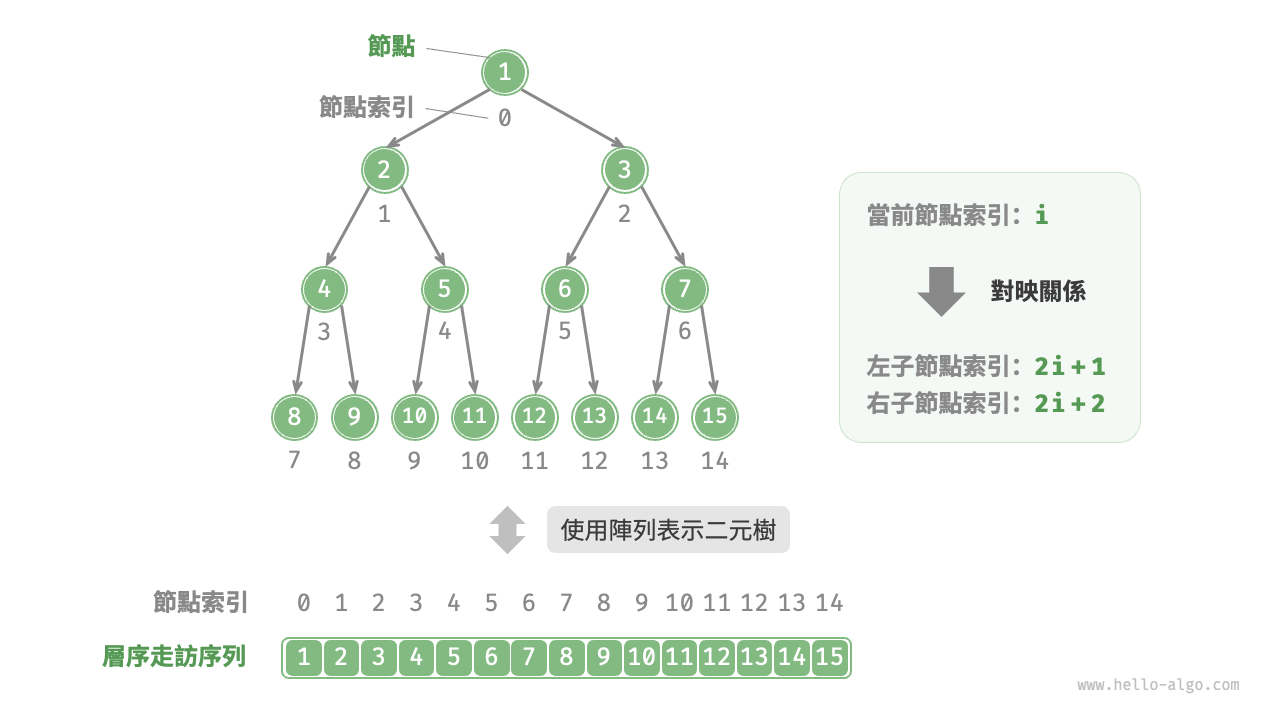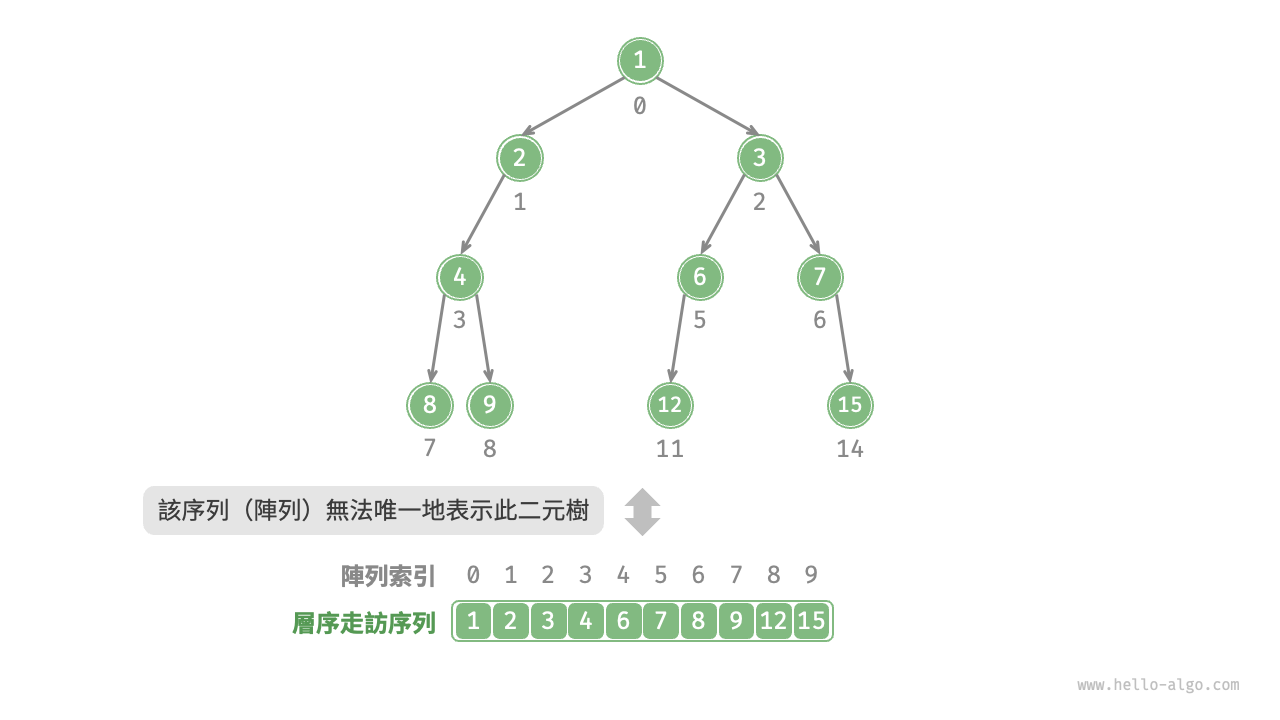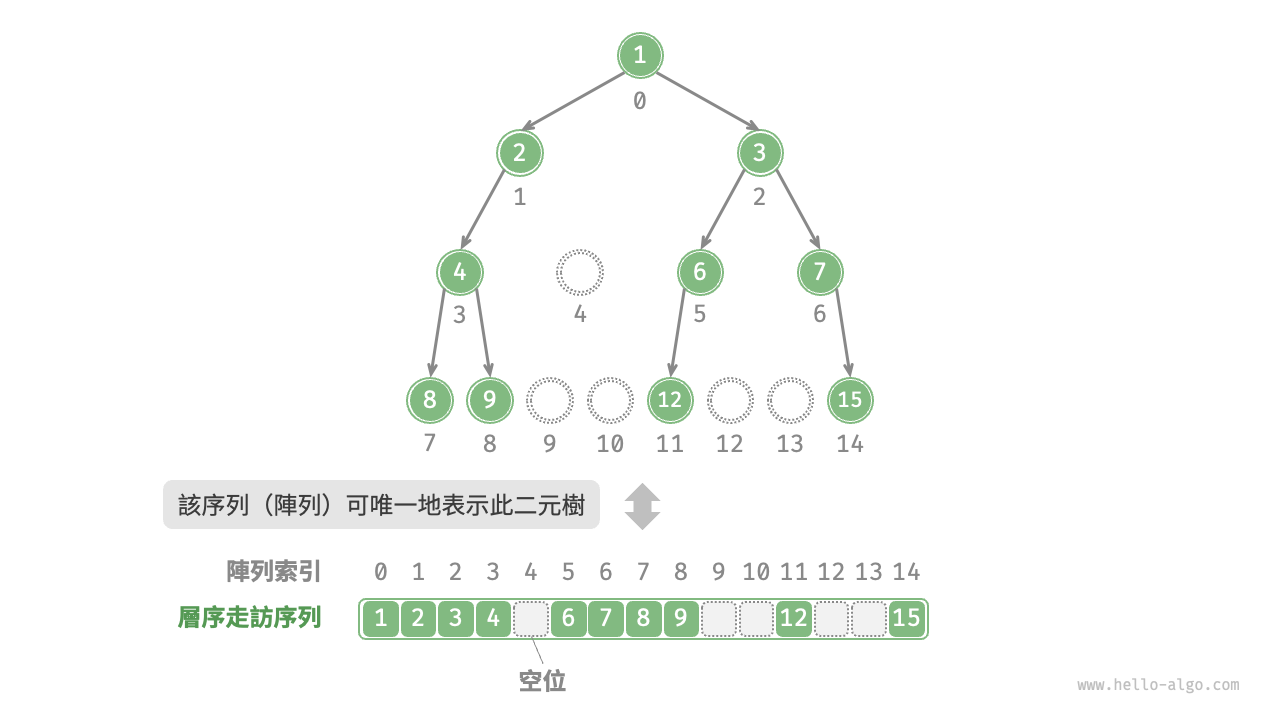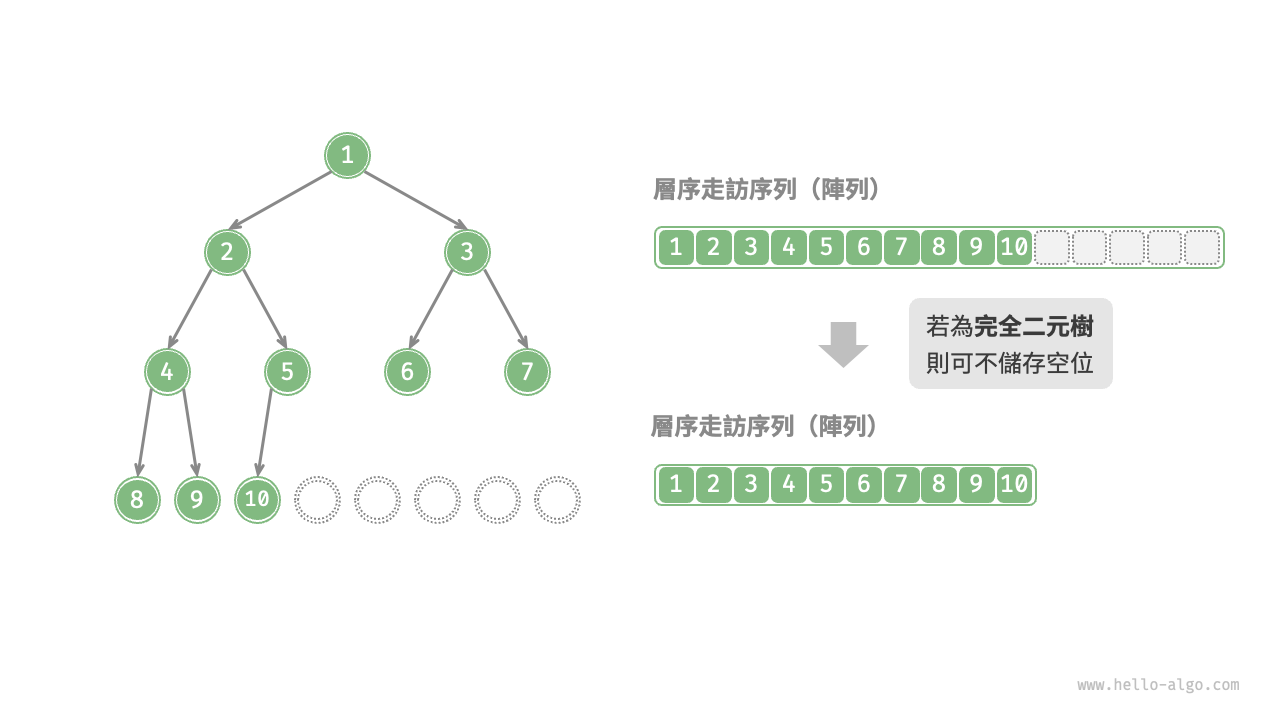7.3 二元樹陣列表示¶
在鏈結串列表示下,二元樹的儲存單元為節點 TreeNode ,節點之間透過指標相連線。上一節介紹了鏈結串列表示下的二元樹的各項基本操作。
那麼,我們能否用陣列來表示二元樹呢?答案是肯定的。
7.3.1 表示完美二元樹¶
先分析一個簡單案例。給定一棵完美二元樹,我們將所有節點按照層序走訪的順序儲存在一個陣列中,則每個節點都對應唯一的陣列索引。
根據層序走訪的特性,我們可以推導出父節點索引與子節點索引之間的“對映公式”:若某節點的索引為 \(i\) ,則該節點的左子節點索引為 \(2i + 1\) ,右子節點索引為 \(2i + 2\) 。圖 7-12 展示了各個節點索引之間的對映關係。
圖 7-12 完美二元樹的陣列表示
對映公式的角色相當於鏈結串列中的節點引用(指標)。給定陣列中的任意一個節點,我們都可以透過對映公式來訪問它的左(右)子節點。
7.3.2 表示任意二元樹¶
完美二元樹是一個特例,在二元樹的中間層通常存在許多 None 。由於層序走訪序列並不包含這些 None ,因此我們無法僅憑該序列來推測 None 的數量和分佈位置。這意味著存在多種二元樹結構都符合該層序走訪序列。
如圖 7-13 所示,給定一棵非完美二元樹,上述陣列表示方法已經失效。
圖 7-13 層序走訪序列對應多種二元樹可能性
為了解決此問題,我們可以考慮在層序走訪序列中顯式地寫出所有 None 。如圖 7-14 所示,這樣處理後,層序走訪序列就可以唯一表示二元樹了。示例程式碼如下:
圖 7-14 任意型別二元樹的陣列表示
值得說明的是,完全二元樹非常適合使用陣列來表示。回顧完全二元樹的定義,None 只出現在最底層且靠右的位置,因此所有 None 一定出現在層序走訪序列的末尾。
這意味著使用陣列表示完全二元樹時,可以省略儲存所有 None ,非常方便。圖 7-15 給出了一個例子。
圖 7-15 完全二元樹的陣列表示
以下程式碼實現了一棵基於陣列表示的二元樹,包括以下幾種操作。
- 給定某節點,獲取它的值、左(右)子節點、父節點。
- 獲取前序走訪、中序走訪、後序走訪、層序走訪序列。
class ArrayBinaryTree:
"""陣列表示下的二元樹類別"""
def __init__(self, arr: list[int | None]):
"""建構子"""
self._tree = list(arr)
def size(self):
"""串列容量"""
return len(self._tree)
def val(self, i: int) -> int | None:
"""獲取索引為 i 節點的值"""
# 若索引越界,則返回 None ,代表空位
if i < 0 or i >= self.size():
return None
return self._tree[i]
def left(self, i: int) -> int | None:
"""獲取索引為 i 節點的左子節點的索引"""
return 2 * i + 1
def right(self, i: int) -> int | None:
"""獲取索引為 i 節點的右子節點的索引"""
return 2 * i + 2
def parent(self, i: int) -> int | None:
"""獲取索引為 i 節點的父節點的索引"""
return (i - 1) // 2
def level_order(self) -> list[int]:
"""層序走訪"""
self.res = []
# 直接走訪陣列
for i in range(self.size()):
if self.val(i) is not None:
self.res.append(self.val(i))
return self.res
def dfs(self, i: int, order: str):
"""深度優先走訪"""
if self.val(i) is None:
return
# 前序走訪
if order == "pre":
self.res.append(self.val(i))
self.dfs(self.left(i), order)
# 中序走訪
if order == "in":
self.res.append(self.val(i))
self.dfs(self.right(i), order)
# 後序走訪
if order == "post":
self.res.append(self.val(i))
def pre_order(self) -> list[int]:
"""前序走訪"""
self.res = []
self.dfs(0, order="pre")
return self.res
def in_order(self) -> list[int]:
"""中序走訪"""
self.res = []
self.dfs(0, order="in")
return self.res
def post_order(self) -> list[int]:
"""後序走訪"""
self.res = []
self.dfs(0, order="post")
return self.res
/* 陣列表示下的二元樹類別 */
class ArrayBinaryTree {
public:
/* 建構子 */
ArrayBinaryTree(vector<int> arr) {
tree = arr;
}
/* 串列容量 */
int size() {
return tree.size();
}
/* 獲取索引為 i 節點的值 */
int val(int i) {
// 若索引越界,則返回 INT_MAX ,代表空位
if (i < 0 || i >= size())
return INT_MAX;
return tree[i];
}
/* 獲取索引為 i 節點的左子節點的索引 */
int left(int i) {
return 2 * i + 1;
}
/* 獲取索引為 i 節點的右子節點的索引 */
int right(int i) {
return 2 * i + 2;
}
/* 獲取索引為 i 節點的父節點的索引 */
int parent(int i) {
return (i - 1) / 2;
}
/* 層序走訪 */
vector<int> levelOrder() {
vector<int> res;
// 直接走訪陣列
for (int i = 0; i < size(); i++) {
if (val(i) != INT_MAX)
res.push_back(val(i));
}
return res;
}
/* 前序走訪 */
vector<int> preOrder() {
vector<int> res;
dfs(0, "pre", res);
return res;
}
/* 中序走訪 */
vector<int> inOrder() {
vector<int> res;
dfs(0, "in", res);
return res;
}
/* 後序走訪 */
vector<int> postOrder() {
vector<int> res;
dfs(0, "post", res);
return res;
}
private:
vector<int> tree;
/* 深度優先走訪 */
void dfs(int i, string order, vector<int> &res) {
// 若為空位,則返回
if (val(i) == INT_MAX)
return;
// 前序走訪
if (order == "pre")
res.push_back(val(i));
dfs(left(i), order, res);
// 中序走訪
if (order == "in")
res.push_back(val(i));
dfs(right(i), order, res);
// 後序走訪
if (order == "post")
res.push_back(val(i));
}
};
/* 陣列表示下的二元樹類別 */
class ArrayBinaryTree {
private List<Integer> tree;
/* 建構子 */
public ArrayBinaryTree(List<Integer> arr) {
tree = new ArrayList<>(arr);
}
/* 串列容量 */
public int size() {
return tree.size();
}
/* 獲取索引為 i 節點的值 */
public Integer val(int i) {
// 若索引越界,則返回 null ,代表空位
if (i < 0 || i >= size())
return null;
return tree.get(i);
}
/* 獲取索引為 i 節點的左子節點的索引 */
public Integer left(int i) {
return 2 * i + 1;
}
/* 獲取索引為 i 節點的右子節點的索引 */
public Integer right(int i) {
return 2 * i + 2;
}
/* 獲取索引為 i 節點的父節點的索引 */
public Integer parent(int i) {
return (i - 1) / 2;
}
/* 層序走訪 */
public List<Integer> levelOrder() {
List<Integer> res = new ArrayList<>();
// 直接走訪陣列
for (int i = 0; i < size(); i++) {
if (val(i) != null)
res.add(val(i));
}
return res;
}
/* 深度優先走訪 */
private void dfs(Integer i, String order, List<Integer> res) {
// 若為空位,則返回
if (val(i) == null)
return;
// 前序走訪
if ("pre".equals(order))
res.add(val(i));
dfs(left(i), order, res);
// 中序走訪
if ("in".equals(order))
res.add(val(i));
dfs(right(i), order, res);
// 後序走訪
if ("post".equals(order))
res.add(val(i));
}
/* 前序走訪 */
public List<Integer> preOrder() {
List<Integer> res = new ArrayList<>();
dfs(0, "pre", res);
return res;
}
/* 中序走訪 */
public List<Integer> inOrder() {
List<Integer> res = new ArrayList<>();
dfs(0, "in", res);
return res;
}
/* 後序走訪 */
public List<Integer> postOrder() {
List<Integer> res = new ArrayList<>();
dfs(0, "post", res);
return res;
}
}
/* 陣列表示下的二元樹類別 */
class ArrayBinaryTree(List<int?> arr) {
List<int?> tree = new(arr);
/* 串列容量 */
public int Size() {
return tree.Count;
}
/* 獲取索引為 i 節點的值 */
public int? Val(int i) {
// 若索引越界,則返回 null ,代表空位
if (i < 0 || i >= Size())
return null;
return tree[i];
}
/* 獲取索引為 i 節點的左子節點的索引 */
public int Left(int i) {
return 2 * i + 1;
}
/* 獲取索引為 i 節點的右子節點的索引 */
public int Right(int i) {
return 2 * i + 2;
}
/* 獲取索引為 i 節點的父節點的索引 */
public int Parent(int i) {
return (i - 1) / 2;
}
/* 層序走訪 */
public List<int> LevelOrder() {
List<int> res = [];
// 直接走訪陣列
for (int i = 0; i < Size(); i++) {
if (Val(i).HasValue)
res.Add(Val(i)!.Value);
}
return res;
}
/* 深度優先走訪 */
void DFS(int i, string order, List<int> res) {
// 若為空位,則返回
if (!Val(i).HasValue)
return;
// 前序走訪
if (order == "pre")
res.Add(Val(i)!.Value);
DFS(Left(i), order, res);
// 中序走訪
if (order == "in")
res.Add(Val(i)!.Value);
DFS(Right(i), order, res);
// 後序走訪
if (order == "post")
res.Add(Val(i)!.Value);
}
/* 前序走訪 */
public List<int> PreOrder() {
List<int> res = [];
DFS(0, "pre", res);
return res;
}
/* 中序走訪 */
public List<int> InOrder() {
List<int> res = [];
DFS(0, "in", res);
return res;
}
/* 後序走訪 */
public List<int> PostOrder() {
List<int> res = [];
DFS(0, "post", res);
return res;
}
}
/* 陣列表示下的二元樹類別 */
type arrayBinaryTree struct {
tree []any
}
/* 建構子 */
func newArrayBinaryTree(arr []any) *arrayBinaryTree {
return &arrayBinaryTree{
tree: arr,
}
}
/* 串列容量 */
func (abt *arrayBinaryTree) size() int {
return len(abt.tree)
}
/* 獲取索引為 i 節點的值 */
func (abt *arrayBinaryTree) val(i int) any {
// 若索引越界,則返回 null ,代表空位
if i < 0 || i >= abt.size() {
return nil
}
return abt.tree[i]
}
/* 獲取索引為 i 節點的左子節點的索引 */
func (abt *arrayBinaryTree) left(i int) int {
return 2*i + 1
}
/* 獲取索引為 i 節點的右子節點的索引 */
func (abt *arrayBinaryTree) right(i int) int {
return 2*i + 2
}
/* 獲取索引為 i 節點的父節點的索引 */
func (abt *arrayBinaryTree) parent(i int) int {
return (i - 1) / 2
}
/* 層序走訪 */
func (abt *arrayBinaryTree) levelOrder() []any {
var res []any
// 直接走訪陣列
for i := 0; i < abt.size(); i++ {
if abt.val(i) != nil {
res = append(res, abt.val(i))
}
}
return res
}
/* 深度優先走訪 */
func (abt *arrayBinaryTree) dfs(i int, order string, res *[]any) {
// 若為空位,則返回
if abt.val(i) == nil {
return
}
// 前序走訪
if order == "pre" {
*res = append(*res, abt.val(i))
}
abt.dfs(abt.left(i), order, res)
// 中序走訪
if order == "in" {
*res = append(*res, abt.val(i))
}
abt.dfs(abt.right(i), order, res)
// 後序走訪
if order == "post" {
*res = append(*res, abt.val(i))
}
}
/* 前序走訪 */
func (abt *arrayBinaryTree) preOrder() []any {
var res []any
abt.dfs(0, "pre", &res)
return res
}
/* 中序走訪 */
func (abt *arrayBinaryTree) inOrder() []any {
var res []any
abt.dfs(0, "in", &res)
return res
}
/* 後序走訪 */
func (abt *arrayBinaryTree) postOrder() []any {
var res []any
abt.dfs(0, "post", &res)
return res
}
/* 陣列表示下的二元樹類別 */
class ArrayBinaryTree {
private var tree: [Int?]
/* 建構子 */
init(arr: [Int?]) {
tree = arr
}
/* 串列容量 */
func size() -> Int {
tree.count
}
/* 獲取索引為 i 節點的值 */
func val(i: Int) -> Int? {
// 若索引越界,則返回 null ,代表空位
if i < 0 || i >= size() {
return nil
}
return tree[i]
}
/* 獲取索引為 i 節點的左子節點的索引 */
func left(i: Int) -> Int {
2 * i + 1
}
/* 獲取索引為 i 節點的右子節點的索引 */
func right(i: Int) -> Int {
2 * i + 2
}
/* 獲取索引為 i 節點的父節點的索引 */
func parent(i: Int) -> Int {
(i - 1) / 2
}
/* 層序走訪 */
func levelOrder() -> [Int] {
var res: [Int] = []
// 直接走訪陣列
for i in 0 ..< size() {
if let val = val(i: i) {
res.append(val)
}
}
return res
}
/* 深度優先走訪 */
private func dfs(i: Int, order: String, res: inout [Int]) {
// 若為空位,則返回
guard let val = val(i: i) else {
return
}
// 前序走訪
if order == "pre" {
res.append(val)
}
dfs(i: left(i: i), order: order, res: &res)
// 中序走訪
if order == "in" {
res.append(val)
}
dfs(i: right(i: i), order: order, res: &res)
// 後序走訪
if order == "post" {
res.append(val)
}
}
/* 前序走訪 */
func preOrder() -> [Int] {
var res: [Int] = []
dfs(i: 0, order: "pre", res: &res)
return res
}
/* 中序走訪 */
func inOrder() -> [Int] {
var res: [Int] = []
dfs(i: 0, order: "in", res: &res)
return res
}
/* 後序走訪 */
func postOrder() -> [Int] {
var res: [Int] = []
dfs(i: 0, order: "post", res: &res)
return res
}
}
/* 陣列表示下的二元樹類別 */
class ArrayBinaryTree {
#tree;
/* 建構子 */
constructor(arr) {
this.#tree = arr;
}
/* 串列容量 */
size() {
return this.#tree.length;
}
/* 獲取索引為 i 節點的值 */
val(i) {
// 若索引越界,則返回 null ,代表空位
if (i < 0 || i >= this.size()) return null;
return this.#tree[i];
}
/* 獲取索引為 i 節點的左子節點的索引 */
left(i) {
return 2 * i + 1;
}
/* 獲取索引為 i 節點的右子節點的索引 */
right(i) {
return 2 * i + 2;
}
/* 獲取索引為 i 節點的父節點的索引 */
parent(i) {
return Math.floor((i - 1) / 2); // 向下整除
}
/* 層序走訪 */
levelOrder() {
let res = [];
// 直接走訪陣列
for (let i = 0; i < this.size(); i++) {
if (this.val(i) !== null) res.push(this.val(i));
}
return res;
}
/* 深度優先走訪 */
#dfs(i, order, res) {
// 若為空位,則返回
if (this.val(i) === null) return;
// 前序走訪
if (order === 'pre') res.push(this.val(i));
this.#dfs(this.left(i), order, res);
// 中序走訪
if (order === 'in') res.push(this.val(i));
this.#dfs(this.right(i), order, res);
// 後序走訪
if (order === 'post') res.push(this.val(i));
}
/* 前序走訪 */
preOrder() {
const res = [];
this.#dfs(0, 'pre', res);
return res;
}
/* 中序走訪 */
inOrder() {
const res = [];
this.#dfs(0, 'in', res);
return res;
}
/* 後序走訪 */
postOrder() {
const res = [];
this.#dfs(0, 'post', res);
return res;
}
}
/* 陣列表示下的二元樹類別 */
class ArrayBinaryTree {
#tree: (number | null)[];
/* 建構子 */
constructor(arr: (number | null)[]) {
this.#tree = arr;
}
/* 串列容量 */
size(): number {
return this.#tree.length;
}
/* 獲取索引為 i 節點的值 */
val(i: number): number | null {
// 若索引越界,則返回 null ,代表空位
if (i < 0 || i >= this.size()) return null;
return this.#tree[i];
}
/* 獲取索引為 i 節點的左子節點的索引 */
left(i: number): number {
return 2 * i + 1;
}
/* 獲取索引為 i 節點的右子節點的索引 */
right(i: number): number {
return 2 * i + 2;
}
/* 獲取索引為 i 節點的父節點的索引 */
parent(i: number): number {
return Math.floor((i - 1) / 2); // 向下整除
}
/* 層序走訪 */
levelOrder(): number[] {
let res = [];
// 直接走訪陣列
for (let i = 0; i < this.size(); i++) {
if (this.val(i) !== null) res.push(this.val(i));
}
return res;
}
/* 深度優先走訪 */
#dfs(i: number, order: Order, res: (number | null)[]): void {
// 若為空位,則返回
if (this.val(i) === null) return;
// 前序走訪
if (order === 'pre') res.push(this.val(i));
this.#dfs(this.left(i), order, res);
// 中序走訪
if (order === 'in') res.push(this.val(i));
this.#dfs(this.right(i), order, res);
// 後序走訪
if (order === 'post') res.push(this.val(i));
}
/* 前序走訪 */
preOrder(): (number | null)[] {
const res = [];
this.#dfs(0, 'pre', res);
return res;
}
/* 中序走訪 */
inOrder(): (number | null)[] {
const res = [];
this.#dfs(0, 'in', res);
return res;
}
/* 後序走訪 */
postOrder(): (number | null)[] {
const res = [];
this.#dfs(0, 'post', res);
return res;
}
}
/* 陣列表示下的二元樹類別 */
class ArrayBinaryTree {
late List<int?> _tree;
/* 建構子 */
ArrayBinaryTree(this._tree);
/* 串列容量 */
int size() {
return _tree.length;
}
/* 獲取索引為 i 節點的值 */
int? val(int i) {
// 若索引越界,則返回 null ,代表空位
if (i < 0 || i >= size()) {
return null;
}
return _tree[i];
}
/* 獲取索引為 i 節點的左子節點的索引 */
int? left(int i) {
return 2 * i + 1;
}
/* 獲取索引為 i 節點的右子節點的索引 */
int? right(int i) {
return 2 * i + 2;
}
/* 獲取索引為 i 節點的父節點的索引 */
int? parent(int i) {
return (i - 1) ~/ 2;
}
/* 層序走訪 */
List<int> levelOrder() {
List<int> res = [];
for (int i = 0; i < size(); i++) {
if (val(i) != null) {
res.add(val(i)!);
}
}
return res;
}
/* 深度優先走訪 */
void dfs(int i, String order, List<int?> res) {
// 若為空位,則返回
if (val(i) == null) {
return;
}
// 前序走訪
if (order == 'pre') {
res.add(val(i));
}
dfs(left(i)!, order, res);
// 中序走訪
if (order == 'in') {
res.add(val(i));
}
dfs(right(i)!, order, res);
// 後序走訪
if (order == 'post') {
res.add(val(i));
}
}
/* 前序走訪 */
List<int?> preOrder() {
List<int?> res = [];
dfs(0, 'pre', res);
return res;
}
/* 中序走訪 */
List<int?> inOrder() {
List<int?> res = [];
dfs(0, 'in', res);
return res;
}
/* 後序走訪 */
List<int?> postOrder() {
List<int?> res = [];
dfs(0, 'post', res);
return res;
}
}
/* 陣列表示下的二元樹類別 */
struct ArrayBinaryTree {
tree: Vec<Option<i32>>,
}
impl ArrayBinaryTree {
/* 建構子 */
fn new(arr: Vec<Option<i32>>) -> Self {
Self { tree: arr }
}
/* 串列容量 */
fn size(&self) -> i32 {
self.tree.len() as i32
}
/* 獲取索引為 i 節點的值 */
fn val(&self, i: i32) -> Option<i32> {
// 若索引越界,則返回 None ,代表空位
if i < 0 || i >= self.size() {
None
} else {
self.tree[i as usize]
}
}
/* 獲取索引為 i 節點的左子節點的索引 */
fn left(&self, i: i32) -> i32 {
2 * i + 1
}
/* 獲取索引為 i 節點的右子節點的索引 */
fn right(&self, i: i32) -> i32 {
2 * i + 2
}
/* 獲取索引為 i 節點的父節點的索引 */
fn parent(&self, i: i32) -> i32 {
(i - 1) / 2
}
/* 層序走訪 */
fn level_order(&self) -> Vec<i32> {
self.tree.iter().filter_map(|&x| x).collect()
}
/* 深度優先走訪 */
fn dfs(&self, i: i32, order: &'static str, res: &mut Vec<i32>) {
if self.val(i).is_none() {
return;
}
let val = self.val(i).unwrap();
// 前序走訪
if order == "pre" {
res.push(val);
}
self.dfs(self.left(i), order, res);
// 中序走訪
if order == "in" {
res.push(val);
}
self.dfs(self.right(i), order, res);
// 後序走訪
if order == "post" {
res.push(val);
}
}
/* 前序走訪 */
fn pre_order(&self) -> Vec<i32> {
let mut res = vec![];
self.dfs(0, "pre", &mut res);
res
}
/* 中序走訪 */
fn in_order(&self) -> Vec<i32> {
let mut res = vec![];
self.dfs(0, "in", &mut res);
res
}
/* 後序走訪 */
fn post_order(&self) -> Vec<i32> {
let mut res = vec![];
self.dfs(0, "post", &mut res);
res
}
}
/* 陣列表示下的二元樹結構體 */
typedef struct {
int *tree;
int size;
} ArrayBinaryTree;
/* 建構子 */
ArrayBinaryTree *newArrayBinaryTree(int *arr, int arrSize) {
ArrayBinaryTree *abt = (ArrayBinaryTree *)malloc(sizeof(ArrayBinaryTree));
abt->tree = malloc(sizeof(int) * arrSize);
memcpy(abt->tree, arr, sizeof(int) * arrSize);
abt->size = arrSize;
return abt;
}
/* 析構函式 */
void delArrayBinaryTree(ArrayBinaryTree *abt) {
free(abt->tree);
free(abt);
}
/* 串列容量 */
int size(ArrayBinaryTree *abt) {
return abt->size;
}
/* 獲取索引為 i 節點的值 */
int val(ArrayBinaryTree *abt, int i) {
// 若索引越界,則返回 INT_MAX ,代表空位
if (i < 0 || i >= size(abt))
return INT_MAX;
return abt->tree[i];
}
/* 層序走訪 */
int *levelOrder(ArrayBinaryTree *abt, int *returnSize) {
int *res = (int *)malloc(sizeof(int) * size(abt));
int index = 0;
// 直接走訪陣列
for (int i = 0; i < size(abt); i++) {
if (val(abt, i) != INT_MAX)
res[index++] = val(abt, i);
}
*returnSize = index;
return res;
}
/* 深度優先走訪 */
void dfs(ArrayBinaryTree *abt, int i, char *order, int *res, int *index) {
// 若為空位,則返回
if (val(abt, i) == INT_MAX)
return;
// 前序走訪
if (strcmp(order, "pre") == 0)
res[(*index)++] = val(abt, i);
dfs(abt, left(i), order, res, index);
// 中序走訪
if (strcmp(order, "in") == 0)
res[(*index)++] = val(abt, i);
dfs(abt, right(i), order, res, index);
// 後序走訪
if (strcmp(order, "post") == 0)
res[(*index)++] = val(abt, i);
}
/* 前序走訪 */
int *preOrder(ArrayBinaryTree *abt, int *returnSize) {
int *res = (int *)malloc(sizeof(int) * size(abt));
int index = 0;
dfs(abt, 0, "pre", res, &index);
*returnSize = index;
return res;
}
/* 中序走訪 */
int *inOrder(ArrayBinaryTree *abt, int *returnSize) {
int *res = (int *)malloc(sizeof(int) * size(abt));
int index = 0;
dfs(abt, 0, "in", res, &index);
*returnSize = index;
return res;
}
/* 後序走訪 */
int *postOrder(ArrayBinaryTree *abt, int *returnSize) {
int *res = (int *)malloc(sizeof(int) * size(abt));
int index = 0;
dfs(abt, 0, "post", res, &index);
*returnSize = index;
return res;
}
/* 陣列表示下的二元樹類別 */
class ArrayBinaryTree(val tree: MutableList<Int?>) {
/* 串列容量 */
fun size(): Int {
return tree.size
}
/* 獲取索引為 i 節點的值 */
fun _val(i: Int): Int? {
// 若索引越界,則返回 null ,代表空位
if (i < 0 || i >= size()) return null
return tree[i]
}
/* 獲取索引為 i 節點的左子節點的索引 */
fun left(i: Int): Int {
return 2 * i + 1
}
/* 獲取索引為 i 節點的右子節點的索引 */
fun right(i: Int): Int {
return 2 * i + 2
}
/* 獲取索引為 i 節點的父節點的索引 */
fun parent(i: Int): Int {
return (i - 1) / 2
}
/* 層序走訪 */
fun levelOrder(): MutableList<Int?> {
val res = mutableListOf<Int?>()
// 直接走訪陣列
for (i in 0..<size()) {
if (_val(i) != null)
res.add(_val(i))
}
return res
}
/* 深度優先走訪 */
fun dfs(i: Int, order: String, res: MutableList<Int?>) {
// 若為空位,則返回
if (_val(i) == null)
return
// 前序走訪
if ("pre" == order)
res.add(_val(i))
dfs(left(i), order, res)
// 中序走訪
if ("in" == order)
res.add(_val(i))
dfs(right(i), order, res)
// 後序走訪
if ("post" == order)
res.add(_val(i))
}
/* 前序走訪 */
fun preOrder(): MutableList<Int?> {
val res = mutableListOf<Int?>()
dfs(0, "pre", res)
return res
}
/* 中序走訪 */
fun inOrder(): MutableList<Int?> {
val res = mutableListOf<Int?>()
dfs(0, "in", res)
return res
}
/* 後序走訪 */
fun postOrder(): MutableList<Int?> {
val res = mutableListOf<Int?>()
dfs(0, "post", res)
return res
}
}
### 陣列表示下的二元樹類別 ###
class ArrayBinaryTree
### 建構子 ###
def initialize(arr)
@tree = arr.to_a
end
### 串列容量 ###
def size
@tree.length
end
### 獲取索引為 i 節點的值 ###
def val(i)
# 若索引越界,則返回 nil ,代表空位
return if i < 0 || i >= size
@tree[i]
end
### 獲取索引為 i 節點的左子節點的索引 ###
def left(i)
2 * i + 1
end
### 獲取索引為 i 節點的右子節點的索引 ###
def right(i)
2 * i + 2
end
### 獲取索引為 i 節點的父節點的索引 ###
def parent(i)
(i - 1) / 2
end
### 層序走訪 ###
def level_order
@res = []
# 直接走訪陣列
for i in 0...size
@res << val(i) unless val(i).nil?
end
@res
end
### 深度優先走訪 ###
def dfs(i, order)
return if val(i).nil?
# 前序走訪
@res << val(i) if order == :pre
dfs(left(i), order)
# 中序走訪
@res << val(i) if order == :in
dfs(right(i), order)
# 後序走訪
@res << val(i) if order == :post
end
### 前序走訪 ###
def pre_order
@res = []
dfs(0, :pre)
@res
end
### 中序走訪 ###
def in_order
@res = []
dfs(0, :in)
@res
end
### 後序走訪 ###
def post_order
@res = []
dfs(0, :post)
@res
end
end
視覺化執行
7.3.3 優點與侷限性¶
二元樹的陣列表示主要有以下優點。
- 陣列儲存在連續的記憶體空間中,對快取友好,訪問與走訪速度較快。
- 不需要儲存指標,比較節省空間。
- 允許隨機訪問節點。
然而,陣列表示也存在一些侷限性。
- 陣列儲存需要連續記憶體空間,因此不適合儲存資料量過大的樹。
- 增刪節點需要透過陣列插入與刪除操作實現,效率較低。
- 當二元樹中存在大量
None時,陣列中包含的節點資料比重較低,空間利用率較低。



